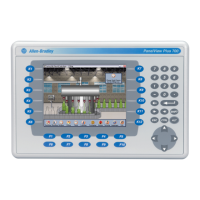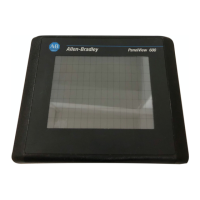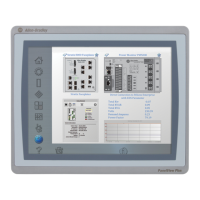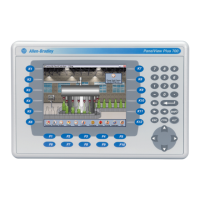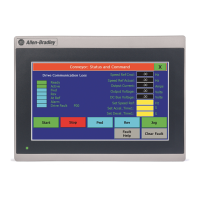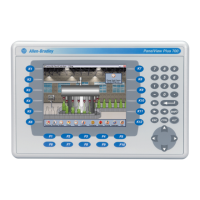
Do you have a question about the Allen-Bradley PanelView Plus 6 700 and is the answer not in the manual?
| Brand | Allen-Bradley |
|---|---|
| Model | PanelView Plus 6 700 |
| Category | Touch terminals |
| Language | English |
Official manual for PanelView Plus 6 terminals.
Provides information on intended audience, resources, and firmware upgrades.
Defines the target audience for the manual and necessary prerequisites.
Details the operating system features and capabilities.
Describes the three main modular components of the terminals.
Lists available PanelView Plus 6 terminal configurations and part numbers.
Provides guidelines for terminal installation environments and enclosures.
Information on operating equipment in hazardous locations.
Details the terminal's USB ports and compliance with hazardous location requirements.
Considerations for maximizing field-life of high-bright displays in outdoor use.
Factors affecting enclosure selection for optimal performance.
Guidance on terminal placement to reduce heat rise due to solar loading.
Provides dimensions for creating panel cutouts for terminal installation.
Step-by-step instructions for securing the terminal in a panel.
Provides essential wiring and safety guidelines for power connections.
Instructions for removing and installing the power terminal block.
Details the power ratings and wire specifications for DC power input.
Mandatory requirements for earth/ground connections for DC power.
Details power ratings and wire specifications for AC power input.
Mandatory connections for protective and functional earth grounding for AC power.
Describes the terminal's power-up sequence and initial configuration mode.
Instructions on how to restart the terminal using the reset switch.
Explains how to enter the terminal's configuration mode.
Allows modification of non-application-specific terminal settings.
Steps to load and execute a FactoryTalk View ME application.
Specifies terminal actions upon startup or reset.
Allows or restricts access to the Windows desktop.
Steps to enable access to the Windows desktop.
Steps to restrict or disallow access to the Windows desktop.
Procedures for setting a password and challenge question for desktop access.
Configures communication settings for applications and controllers.
Edits driver settings for communication protocols used by applications.
Configures Ethernet information like IP address and link speed.
Steps to edit the address of a device, such as a logic controller.
Instructions for manually setting or enabling DHCP for the terminal's IP address.
Specifies DNS and WINS server addresses for the Ethernet/IP network adapter.
Supports managing files stored on the terminal.
Configures user name, password, and domain for network resource access.
Steps to delete application or font files from storage locations.
Instructions for deleting generated log, alarm history, and alarm status files.
Steps to copy application or font files between storage locations.
Adjusts display intensity, temperature, screen saver, and cursor.
Modifies the terminal backlight intensity for runtime operations.
Displays current terminal temperature and backlight behavior.
Adjusts screen saver idle timeout, intensity, and bitmap options.
Allows enabling or disabling the visible screen cursor.
Adjusts settings for keypad, keyboard, mouse, touch screen, and string entry popup.
Adjusts repeat rate and delay settings for terminal keys.
Recalibrates the touch screen for accurate response to taps.
Specifies using standard input panel or popup keyboard for string entry.
Sets and tests the double-tap sensitivity of touch screen presses.
Configures settings for printing displays, alarm, and diagnostic messages.
Periodically checks application and runtime file integrity and logs errors.
Configures diagnostic settings, including remote log destination.
Displays and clears terminal warnings, errors, and events.
Views terminal information and firmware revision details.
Displays read-only terminal information like power-on time and battery state.
Displays firmware and version info for installed system components.
Controls whether the alarm display closes upon acknowledgment.
Allows changing date, time, time zone, and regional settings.
Adjusts the terminal's date settings (Year, Month, Day).
Modifies the terminal's current time zone and daylight savings settings.
Adjusts regional settings for language, date, time, and numeric formats.
Selects the language for the terminal's operating system and interface.
Adjusts the time format (e.g., AM/PM, 24-hour) for the selected language.
Modifies the short date format (e.g., M/D/YYYY) for the selected language.
Modifies the long date format (e.g., Day, Month DD, YYYY) for the selected language.
Links font files to base fonts for running translated applications.
Lists the standard features supported by the Windows CE 6.0 OS.
Describes the shell and UI support features provided by the OS.
Lists servers supported by the Windows CE 6.0 operating system.
Highlights additional OS components for terminals with extended features.
The primary interface for configuring system-wide properties on the terminal.
Provides status and troubleshooting info for terminals.
Displays warnings, errors, and events logged by the terminal.
Provides continuous temperature, voltage, and load information.
Displays visual status and voltage reading of the battery for the real-time clock.
Adjusts settings for the terminal's membrane keypad.
Calibrates the touch screen and sets touch screen tap sensitivity.
Controls desktop background, appearance, backlight, and screen saver.
Sets the brightness level of the display between 1% and 100%.
Extends display life by dimming backlight during idle periods.
Enables or disables the visible cursor on the display.
Shows supported servers and allows enabling or disabling them.
Provides tabs to view and set system-wide properties for the terminal.
Lets you show/hide battery warnings, watchdog errors, and set open/closed system.
Allows running the terminal as an open or closed system at startup.
Lists supported USB printers and configuration methods.
Steps for installing plug-and-play printers from the Windows desktop.
Steps for manually setting up a supported printer.
Accessing Windows Explorer from the desktop.
Provides PDF view and search functions, accessible from desktop or prompt.
Lists tools needed for installing and replacing components.
Advises disconnecting power and avoiding ESD when handling components.
Step-by-step instructions for attaching or replacing the logic module.
Instructions for installing or replacing a communication module.
Step-by-step instructions for replacing the display module.
Instructions for replacing the display module bezel.
Step-by-step guide to removing the display module bezel.
Steps to reattach the display module bezel and associated components.
Detailed steps for replacing the terminal's lithium battery.
Instructions for replacing the display module backlight.
Instructions for removing and replacing the product ID label.
Steps to replace keypad legend inserts for custom legends.
Instructions for inserting SD cards or USB flash drives for storage.
Provides instructions for safely cleaning the terminal display screen.
Provides wiring and safety guidelines for device connections.
Summarizes PanelView Plus 6 connections to SLC and PLC controllers.
Details electrical isolation for integral and modular communication ports.
Describes the terminal's USB ports and their connections.
Explains the serial RS-232 port and its supported connections.
How to connect the terminal to a computer via RS-232 for uploads/downloads.
Details the Ethernet port and its supported connections.
Describes the RJ45 Ethernet connector and status indicators.
Details the DH-485/DH+ communication module and status indicators.
Wiring instructions for attaching RS-485 connectors to cables.
Guidelines for connecting a terminal to a DH+ link using specific cables.
Information on ControlNet communication and compatible controllers.
Lists software and firmware requirements for ControlNet communication.
Explains how firmware components are packaged and updated.
Steps to download firmware installation packages from the Rockwell website.
Two-step process to create and load firmware from a storage device.
Steps to copy firmware files to a USB flash drive or SD card.
Steps to transfer firmware files from a storage card to the terminal.
Steps to upgrade firmware via a network connection using RSLinx Enterprise.
Explains COMM and FAULT indicators for isolating anomalies.
General troubleshooting information to assist in isolating anomalies.
Tips for diagnosing issues related to inadequate power supply.
Interpreting indicator states during startup to diagnose faults.
Guides users to check startup messages and error codes.
Procedures to check battery voltage, CPU, and display temperatures.
Lists startup messages and their associated status or error codes.
Tips for isolating anomalies with display, touch screen, keypad, or mouse.
Tips for isolating and resolving Ethernet anomalies.
Troubleshooting steps for when a terminal application fails to run.
How to access Configuration mode when an application is running or during startup.
Using network tools and other utilities for advanced diagnostics.
Steps to access Maintenance mode for diagnostic and repair purposes.
Detailed technical specifications for PanelView Plus 6 terminals.
Details operating temperature, humidity, vibration, and shock specifications.
Lists safety and compliance certifications for the terminals.
Lists pre-installed True Type fonts and their file names.
Shows Windows virtual key codes for function keys and keypad keys.
